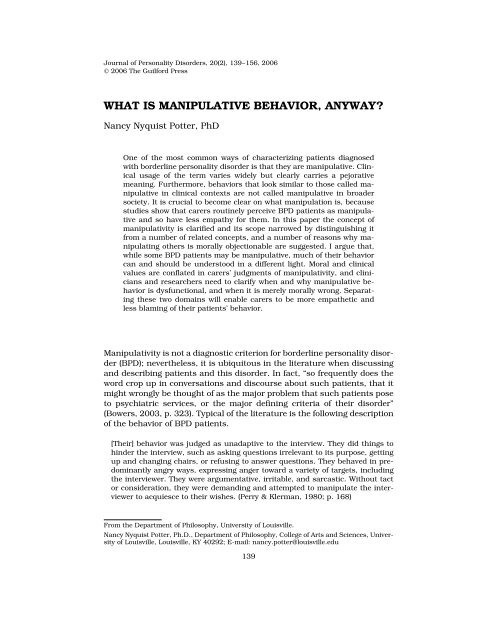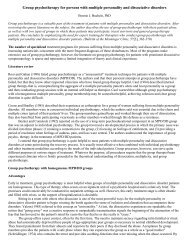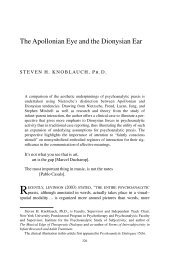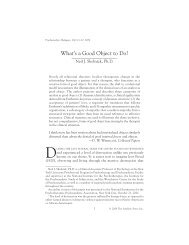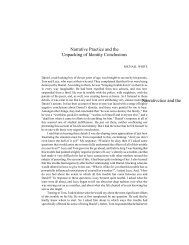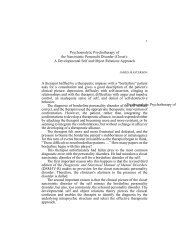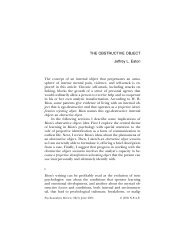WHAT IS MANIPULATIVE BEHAVIOR, ANYWAY? - PsyBC
WHAT IS MANIPULATIVE BEHAVIOR, ANYWAY? - PsyBC
WHAT IS MANIPULATIVE BEHAVIOR, ANYWAY? - PsyBC
Create successful ePaper yourself
Turn your PDF publications into a flip-book with our unique Google optimized e-Paper software.
Journal of Personality Disorders, 20(2), 139–156, 2006<br />
© 2006 The Guilford Press<br />
<strong>WHAT</strong> <strong>IS</strong> <strong>MANIPULATIVE</strong> <strong>BEHAVIOR</strong>, <strong>ANYWAY</strong><br />
Nancy Nyquist Potter, PhD<br />
One of the most common ways of characterizing patients diagnosed<br />
with borderline personality disorder is that they are manipulative. Clinical<br />
usage of the term varies widely but clearly carries a pejorative<br />
meaning. Furthermore, behaviors that look similar to those called manipulative<br />
in clinical contexts are not called manipulative in broader<br />
society. It is crucial to become clear on what manipulation is, because<br />
studies show that carers routinely perceive BPD patients as manipulative<br />
and so have less empathy for them. In this paper the concept of<br />
manipulativity is clarified and its scope narrowed by distinguishing it<br />
from a number of related concepts, and a number of reasons why manipulating<br />
others is morally objectionable are suggested. I argue that,<br />
while some BPD patients may be manipulative, much of their behavior<br />
can and should be understood in a different light. Moral and clinical<br />
values are conflated in carers’ judgments of manipulativity, and clinicians<br />
and researchers need to clarify when and why manipulative behavior<br />
is dysfunctional, and when it is merely morally wrong. Separating<br />
these two domains will enable carers to be more empathetic and<br />
less blaming of their patients’ behavior.<br />
Manipulativity is not a diagnostic criterion for borderline personality disorder<br />
(BPD); nevertheless, it is ubiquitous in the literature when discussing<br />
and describing patients and this disorder. In fact, “so frequently does the<br />
word crop up in conversations and discourse about such patients, that it<br />
might wrongly be thought of as the major problem that such patients pose<br />
to psychiatric services, or the major defining criteria of their disorder”<br />
(Bowers, 2003, p. 323). Typical of the literature is the following description<br />
of the behavior of BPD patients.<br />
[Their] behavior was judged as unadaptive to the interview. They did things to<br />
hinder the interview, such as asking questions irrelevant to its purpose, getting<br />
up and changing chairs, or refusing to answer questions. They behaved in predominantly<br />
angry ways, expressing anger toward a variety of targets, including<br />
the interviewer. They were argumentative, irritable, and sarcastic. Without tact<br />
or consideration, they were demanding and attempted to manipulate the interviewer<br />
to acquiesce to their wishes. (Perry & Klerman, 1980; p. 168)<br />
From the Department of Philosophy, University of Louisville.<br />
Nancy Nyquist Potter, Ph.D., Department of Philosophy, College of Arts and Sciences, University<br />
of Louisville, Louisville, KY 40292; E-mail: nancy.potter@louisville.edu<br />
139
140 POTTER<br />
The described behaviors are at least different in degree, if not in kind, from<br />
self-injurious behavior or suicide threats, the sine qua non of BPD patients.<br />
Yet clinicians tend to equate BPD patients with manipulativity and<br />
to forewarn others about them. For example, one researcher claims to distinguish<br />
BPD patients from depressed or schizophrenic ones by “their<br />
angry, demanding, and entitled presentation,” and another warns that<br />
“any interviewer, whether with a clinical or research purpose, will be exposed<br />
to devaluation, manipulation, angry outbursts, clinging or appeal”<br />
(quoted in Mitton & Huxley, 1988, p. 341). Most bluntly, “borderliners are<br />
the patients you think of as PIAs—pains in the ass” (“The ‘Borderline’ Personality,”<br />
1983, p. 51). As I will show, what clinicians and staff mean by<br />
manipulative behavior varies widely. Because manipulativity is a pejorative<br />
term, and because it refers to behavior that is thought to require management,<br />
the use of the term needs to be more precise. The aim of this essay<br />
is to isolate the behavior most appropriately called manipulative and to<br />
identify reasons why it might be a problem for patients to be manipulative.<br />
Current clinical usage collapses the distinction between moral values<br />
about wrong behavior and clinical values about psychological dysfunction,<br />
and part of the task is to separate those two domains.<br />
To open the enquiry, let’s consider the following transcript. This exchange<br />
takes place the night before the first scheduled appointment between<br />
a therapist and a BPD patient, because the patient experiences a<br />
medical emergency. Here is the exchange:<br />
Ms. A: You could be dying before you got any help around here! My arm<br />
is killing me! This place is crazy!<br />
Therapist: Ms. A, I would like to introduce myself. I am Dr. Wheelis.<br />
Ms. A: Oh, no kidding! I didn’t expect you. You’re a resident Interesting.<br />
You must be either very good or very crazy to have taken me on.<br />
Therapist: I can’t tell if that’s an invitation, a warning, or both [patient<br />
smiled at the comment], but we have an appointment tomorrow. Why<br />
don’t we discuss it then. For now, perhaps I should take a look at your<br />
arm.<br />
Ms. A: No, it’s okay, just a little bang.<br />
Therapist: Are you sure You suggested that it was giving you considerable<br />
pain.<br />
Ms. A: No, it’s fine, really. I’ll see you tomorrow. By the way, I hate being<br />
called Ms. A.<br />
Therapist: How would you like to be called<br />
Ms. A: Lotta. That’s what everyone calls me.<br />
Therapist: Very well, as you wish. (Wheelis & Gunderson, 1998, p. 114)<br />
An echo of Perry and Klerman’s (1980) assessment of BPDs can be found<br />
in the discussion of the transcript provided by her therapist and the coauthor:
<strong>MANIPULATIVE</strong> <strong>BEHAVIOR</strong> 141<br />
Already in this initial interaction with Lotta’s therapist-to-be, harbingers of the<br />
therapeutic challenges are evident. Ms. A demonstrates a manipulative style that<br />
predates the first interaction by seeking help through the exaggeration of a minor<br />
physical complaint. There is also the hint that Ms. A may be taking pleasure<br />
in suggesting to the therapist-to-be that working with her will be more than a<br />
small challenge. Her final request, to be called Lotta [rather than Ms. A] betrays<br />
her desire to bypass professional formality by requesting an immediate familiarity.<br />
(Wheelis & Gunderson,1998, p. 114)<br />
The commentary suggests that the therapist may have given more weight<br />
to the diagnostic category in which Lotta is said to fit than to the particular<br />
person who is Lotta. In such an encounter, the therapist sees markers<br />
of BPD: manipulativity, efforts to control others, repudiation of socially<br />
accepted boundaries, and resistance to socially approved conduct. But is<br />
it correct to characterize Lotta’s behavior in this encounter as manipulative<br />
And is her behavior dysfunctional, or just irritating<br />
CONCEPTUAL CLOUDINESS<br />
We cannot answer the question of what is wrong with manipulativity until<br />
we know what it is. To begin with, I present several examples of the way<br />
the term is used with an eye to showing how sloppy its application is. Then<br />
I offer a cleaner definition but one that leaves crucial questions unanswered<br />
about the distinction between dysfunctional and morally objectionable<br />
behavior. The latter half of the paper addresses these issues.<br />
CLINICAL USES OF THE TERM <strong>MANIPULATIVE</strong><br />
Little research has been conducted on how the term manipulation is used<br />
in a clinical setting, but what has been done suggests that people mean<br />
many things, all of them negative.<br />
• In one study, six different types of behaviors—ranging from bullying,<br />
intimidation, and physical violence to building special relationships in<br />
order to secure clinician compliance to conning and lying—were labeled<br />
manipulation by nurses. (Bowers, 2002)<br />
• In the Hare Psychopathy Checklist (cited in Bowers, 2002), lying and<br />
making false promises are distinguished from manipulativity, where<br />
manipulation is defined as deception used for personal gain, without<br />
concern for victims.<br />
• The Fallon Inquiry (cited in Bowers, 2002) included, as manipulative<br />
behavior, patients who threatened to make official complaints if they<br />
were not treated the way they thought was right.<br />
Bowers (2003) offered a definition of manipulation that takes into account<br />
this broad array of behavior yet distills it so that it has some clarity:<br />
Manipulativity is activity that aims “to achieve a desired goal (perverse or
142 POTTER<br />
normal, symbolic or real) using deception, coercion and trickery, without<br />
regard for the interests or needs of those used in the process” (p. 325).<br />
Gunderson (1984) defines manipulation as “those efforts by which covert<br />
means are used to control or gain support from significant others. Typical<br />
ways include somatic complaints, provocative actions, or misleading messages,<br />
as well as self-destructive acts” (1984, p. 5).<br />
Other researchers classify manipulation as a type of covert or indirect<br />
aggression, where the aggression is disguised, and they define aggression<br />
as “a response, the intent of which is to injure another person” (Kaukianinen<br />
et al., 2001, p. 363). Indirect aggression typically is circuitous, and<br />
the aggressor tries to “hide his or her overt intentions to harm others by<br />
applying strategies, which disguise aggression in the form of discreet or<br />
malicious insinuations” (p. 363). Examples of covert insinuative aggression<br />
include use of negative glances and gestures; do-not-speak-to-me behaviors;<br />
interrupting someone on purpose; imitating an employee’s style<br />
of walk, expressions, or gestures in a derogative manner; refusing to listen<br />
to the other person; and hinting that the other person has mental problems<br />
(Kaukianinen et al., 2001). One question, then, is whether manipulation<br />
is a type of aggression or other deliberately injurious behavior and, in<br />
particular, whether the behavior of patients diagnosed with BPD should<br />
rightly be conceptualized this way. But the more difficult problem is that<br />
the concept of manipulation has such broad meaning in the clinical lexicon<br />
and it is not clear what behavior clinicians are objectively observing<br />
that should count as manipulative.<br />
USES OF THE TERM IN BROADER SOCIETY<br />
Here I want to pose examples drawn from nonclinical situations. Some of<br />
these examples are claimed, by the writer, to be forms of manipulation.<br />
Others may fit a definition of manipulation but are not called that. This<br />
section illustrates differences in how the concept of manipulativity is employed<br />
in clinical settings from broader society and presents more puzzles<br />
about what sort of behavior should be called manipulative.<br />
The first example involves a stripper and her customer, an interaction<br />
which “is a complicated mixture of manipulation and control of emotions<br />
and communication” (Pasko, 2002, p. 63). Pasko argues that strippers are<br />
experienced at managing the emotions of their customers in order to earn<br />
a monetary reward. They play two roles: sex object for their customers and<br />
impersonators of “counterfeit intimacy” (p. 56). But how they play out<br />
those roles depends on the individual customer’s needs, so skillful strippers<br />
are adept at reading their customers. “Knowing when to act seductive,<br />
when to remain still and simply be nude, when to shock a shy customer<br />
with a sudden revelation of nudity and when to be talkative, come from a<br />
dancer’s ability to decode men’s sexual wishes” (p. 58).<br />
Prima facie, it may be right to characterize strippers as manipulating the<br />
emotions and desires of their customers. But this kind of interaction is
<strong>MANIPULATIVE</strong> <strong>BEHAVIOR</strong> 143<br />
importantly different from behaviors like lying and deceiving, because the<br />
customer has come to the strip joint for the purpose of having his fantasies<br />
played out. The stripper and the customer are aware that the stripper is<br />
playing a role and that, to do so successfully, she must intuit his needs<br />
sufficiently to satisfy him. The customer knows that the stripper is working<br />
to earn a tip, although he brackets off that knowledge in order to participate<br />
in the game. So this kind of interaction is more like socially agreedupon<br />
moves people make in a given context. In other words, I am arguing<br />
that some forms of behavior that might appear to be manipulative involve<br />
complex negotiations of people in social roles, or are entered into with an<br />
implicit understanding.<br />
A similar case can be made for flight attendants. In a training program<br />
for airline flight attendants, the trainees were told:<br />
You think how the new person resembles someone you know. You see your sister’s<br />
eyes in someone sitting at that seat. That makes you want to put out for<br />
them. I like to think of the [airplane] cabin as the living room of my own home.<br />
When someone drops in [at home], you may not know them, but you get something<br />
for them. You put that on a grand scale—thirty-six passengers per flight<br />
attendant—but it’s the same feeling. (Hochschild, 1983, p. 105)<br />
Hochschild does not identify this thinking as a precursor to manipulativity<br />
but does argue that flight attendants and other service workers are explicitly<br />
taught to manage the emotions of customers (and themselves.) The<br />
flight attendant, for example, is expected to act pleased to serve the travelers<br />
and to experience pleasure from her or his job. But, as with the example<br />
of the stripper-customer interaction, I argue that managing others’<br />
emotions to gain an outcome one desires is not always manipulative. Travelers<br />
are not fooled by gracious and pleasant behavior into thinking that<br />
each of us is special and brings a warm glow to the flight attendant who<br />
serves us; this interaction, too, is based on social understandings of roles<br />
and norms for behavior in a particular context. In neither the case of the<br />
stripper nor the flight attendant are the behaviors malicious or deliberately<br />
injurious. They are socially prescribed interactions that are entered into<br />
with tacit agreement of the norms of interaction in those exchanges.<br />
Con artists are called manipulative, but their interactional relation is<br />
different. What distinguishes this case from the examples above is that the<br />
con game can only work if the victim is ignorant of what is truly occurring.<br />
“The confidence game is an act of trust development, fake pretenses and<br />
duplicity in order to acquire some kind of gain, usually monetary. The<br />
confidence game, like many acts of deception, is an assumption of power.<br />
. . . The confidence person, or swindler, often enjoys the development and<br />
exercise of power over their victims, repetitively proving his or her cleverness<br />
and superiority” (Pasko, 2002, p. 52). Con artists depend on deceit to<br />
fool their victims, and their explicit aim is to gain something from the victim<br />
that he or she would not otherwise have surrendered. This case does<br />
seem to fit the general idea of manipulation as bad means to achieve one’s
144 POTTER<br />
ends, but I will argue later that deception and manipulation are analytically<br />
separate concepts. For now, let me offer two more examples from<br />
broader society that are a bit messier.<br />
In a novel about a middle-aged woman having an affair with a young<br />
boy, the narrator says of the boy:<br />
It is pretty clear to me that there was a strong element of calculation in these<br />
little bursts of wistfulness and wonderment. By which I do not mean to imply<br />
that the boy was cynical exactly. Simply anxious to please. He had observed that<br />
Sheba liked him best when he was saying sensitive things about paintings and<br />
so on, and he was beefing up his moony ponderings accordingly. If this is cynical,<br />
then we must allow that all courtship is cynical. Connolly was doing as all<br />
people do in such situations—tricking out his stall with an eye to what would<br />
best please his customer. (Heller, 2003, pp. 46–47)<br />
Courtship rituals, although culturally varied, typically include the assumptions<br />
that the other is presenting his or her best, downplaying or<br />
perhaps suppressing one’s bad tendencies, and attending to the beloved<br />
with an aim to please. Do people’s interactions when entering into new<br />
potential intimacies involve a kind of manipulation It depends. On the<br />
one hand, courtship is similar to the stripping and service industries in<br />
that it involves a tacit understanding of the rules of romance. It seems<br />
best viewed as a social negotiation that both parties know involves some<br />
exaggeration and some disguise. If Sheba likes daffodils and Connolly<br />
brings her a bouquet, most people would not see that action as manipulative.<br />
On the other hand, deception can run deep. Connolly could be posing<br />
as a lover when he really wants access to her money, or her younger sister.<br />
But then why not just call it deception or exploitation Courtship per se<br />
isn’t manipulative, and it’s the context of the situation that will determine<br />
how to evaluate an interaction.<br />
The last example also makes this point. Recall that, in clinical literature,<br />
one type of behavior that counted as manipulative was patients who<br />
threated to make official complaints if they were not treated the way they<br />
thought was right. But consider this type of behavior in another context.<br />
The United States has had a long history of nonviolent strikes and other<br />
forms of protest over unfair labor conditions. For example, “In the women’s<br />
garment industry, as far back as 1910, workers have ceased operations<br />
without leaving the shop. Partly this has been done when a contract forbade<br />
strikes, the workers arguing that a mere stoppage was not a violation”<br />
(Lynd & Lynd, 1995, pp. 142). Protests and strikes occur when people<br />
are experiencing injustice or a violation of their rights and other forms of<br />
redress are unavailable. When power imbalances exist and the more powerful<br />
party refuses to negotiate in good faith, the less powerful may<br />
threaten other actions such as strikes or protests. Are threats always manipulative<br />
A threat to strike may simply be the next move in a frustrating<br />
attempt to be taken seriously. In our society, we do not ordinarily talk<br />
about threats to strike as manipulative (although employers might frame
<strong>MANIPULATIVE</strong> <strong>BEHAVIOR</strong> 145<br />
it that way). Furthermore, it’s not clear that attempts to claim a right to<br />
be treated fairly should fall into the category of “intent to harm.”<br />
This example raises the question of why BPD patients who are similarly<br />
less powerful and need pathways to ensure fair treatment are called manipulative<br />
when they threaten to take advantage of those securities. Bowers<br />
(2002) argues that, while some complaints are justifiable and for good<br />
cause, others seem to be done spitefully or over trivial matters. He says<br />
that “the formal complaints procedure can be very destructive, can cause<br />
much worry even among those who have only witnessed what it has done<br />
to others, and is costly in terms of management time, suspensions, illness<br />
and resignations at a time when nursing staff are a scarce resource” (p.<br />
62). Putting Bowers’ ideas together with the above argument, I would say<br />
that manipulativity in patients who threaten to make official complaints<br />
would not consist in the activity per se but in a cluster of other issues that<br />
must be viewed in context, such as what a particular patient’s motives are,<br />
what events preceded the complaint, how dysfunctional the patient is, and<br />
so on. In other words, the act of threatening to make an official complaint<br />
does not entail manipulativity any more than the act of threatening to<br />
strike does.<br />
Considering these examples, one finds considerable messiness in the<br />
usage and meaning of manipulative in broader society as well as in clinical<br />
contexts. There appear to be two problems in the use of the term manipulation.<br />
One is that, even in the restricted domain of clinical contexts, the<br />
class of behaviors is over-inclusive. Research suggests that clinicians include<br />
under the umbrella term of manipulativity everything from bullying,<br />
intimidation, physical violence, building special relationships, conning<br />
and lying, using deception for personal gain without concern for victims,<br />
to threatening to make official complaints if a request was not met (Bowers,<br />
2003). With such a range of behaviors, the primary message seems to<br />
be a negative judgment—vague in content but powerful in effect. Clinicians<br />
use the term as a superordinate category under which morally wrong<br />
ways of interacting are included. But lumping all these behaviors together<br />
is not therapeutically useful, because it doesn’t allow for differentiation<br />
between kinds of behavior that vary among BPD patients. Furthermore,<br />
moral wrongdoings (such as lying) are distinguished from other kinds of<br />
wrongdoing (such as being divisive) both in moral theory and in ordinary<br />
language; the action, intention, and type of harm done are part of the evaluation<br />
of what makes each action wrong, and the identifying features of<br />
each of these moral wrongs are importantly different. So it is a mistake for<br />
clinicians to group all these behaviors under a general heading of manipulativity.<br />
The second problem is that a mismatch exists between the meaning of<br />
the term in everyday settings and in clinical settings. Clinically, the term<br />
refers to behaviors such as lying, bullying, intimidating, demanding fair<br />
treatment, creating divisions, and corrupting others. In ordinary life, many<br />
similar behaviors are not called manipulative. Is this mismatch war-
146 POTTER<br />
ranted Are all of us more manipulative than we think—and, if so, what<br />
would that finding indicate about the ordinary person’s mental health Or<br />
are BPD patients being held to a higher standard of behavior and interaction<br />
than are others<br />
Most people occasionally deceive, are indirect about what they want, disguise<br />
their true feelings, and intimidate others (Goffman, 1952). But BPD<br />
patients are routinely characterized—pejoratively—as manipulative. Why<br />
are patients viewed through this lens rather than seen as participants in<br />
an acceptable social-role interaction in the context, or engaged in a type of<br />
persuasion, or as making a move in a negotiation How can we distinguish<br />
normal manipulative behavior from pathological, especially with the apparent<br />
variations between behavior and usage<br />
Let me take the latter question first. We might conclude that manipulation<br />
is a matter of degree: a continuum from “normal quid quo pros of<br />
everyday social life” (Bowers, 2003, p. 326) to habitual, deeply ingrained<br />
patterns from which everything flows. This move would require us to distinguish<br />
manipulative acts from manipulative character. The borderline<br />
personality, then, would have a manipulative character.<br />
This move is too quick, though, because one cannot rule out the possibility<br />
that patients perform complex negotiations in their relationships<br />
with clinicians and that those interactions are socially encoded in the patients’<br />
view. The patient role is a core function of health care and, although<br />
Internet access has empowered some patients to a degree, the social expectations<br />
for behavior of those in the patient role are still that of subordination<br />
to expertise and authority, compliance, and a bit of humility. Patients<br />
who challenge the traditional norms of the role are seen as noncompliant<br />
and, as in the opening transcription between Lotta (“Ms. A”) and the therapist,<br />
as indicators of the patient’s disordered personality. An alternative<br />
would be to consider how the patient is attempting to navigate clearly delineated<br />
relations of power and to negotiate shifts in social roles so as not<br />
to feel powerless and beholden.<br />
Another approach to distinguish between everyday and pathological<br />
manipulativity is to identify what forms of manipulativity are dysfunctional<br />
or maladaptive. Numerous clinicians, in describing the BPD’s noncompliant,<br />
self-injurious, and manipulative behaviors, refer to such behavior<br />
as maladaptive (cf. Harvey & Watters, 1998). To call BPD manipulativity<br />
maladaptive, though, merely pushes the question back: why, and when,<br />
is manipulativity maladaptive If I am right that behavior that is called<br />
manipulative in clinical settings is condoned, expected, or not even noticed<br />
in nonclinical settings, we need to have a noncircular way of identifying<br />
pathological manipulation. I return to this point later.<br />
For now, let me address the second question: Why are patients viewed<br />
through a lens of dysfunctional manipulation rather than seen as participants<br />
in tacitly understood social interactions, or engaged in a type of persuasion,<br />
or as making a move in a negotiation The reason is that clinicians<br />
are as likely to perceive manipulative behavior based on preconceived no-
<strong>MANIPULATIVE</strong> <strong>BEHAVIOR</strong> 147<br />
tions of BPD patients as they are to base judgments on clear and objective<br />
perception. That is, their perceptions may be based on stereotypes of BPD<br />
patients. For example, researchers Gallop, Lancee, and Garfinkel (1989)<br />
asked: “Do patients diagnosed with BPD receive qualitatively different care<br />
from patients diagnosed with other [non-personality-disordered] diagnoses”<br />
(p. 815). Hypothetical vignettes in which the only variable was presence<br />
or absence of a diagnosis of personality disorder suggested that stereotyped<br />
perceptions play a crucial role in how the behavior of BPD<br />
patients are interpreted and responded to. “The difficult behavior of the<br />
patient with borderline personality disorder is often seen as ‘bad’ and ‘deliberate’<br />
rather than as ‘sick.’ . . . The schizophrenic patient, on the other<br />
hand, is not perceived as having this control” (p. 815). Schizophrenic patients<br />
are perceived as ill, whereas “borderline patients . . . do not meet<br />
the criteria of ‘good and attractive’ patients. They are not perceived as sick,<br />
compliant, cooperative, or grateful” (p. 819). The researchers conclude<br />
that “the label [BPD] is sufficient to diminish staff’s expressed empathy”<br />
(p. 815). Nurses were more likely to give responses that indicated affective<br />
involvement if the patient’s diagnosis was schizophrenia, and were more<br />
likely to give responses that were belittling or contradicting if the patient’s<br />
diagnosis was BPD. The researchers suggest that clinicians and staff may<br />
believe that BPD patients deserve less empathetic treatment and that their<br />
diagnosis is bad or manipulative (Gallop et al., 1989). Research by Bowers<br />
(2002) returned similar responses: nurses were virtually unanimous that<br />
these patients are to blame for their behavior. The nurses reason that,<br />
unless a patient is deluded or hallucinating, or confused or muddled, the<br />
patient knows what she or he is doing and is therefore responsible for those<br />
actions.<br />
This discussion thus points to three questions. (1) Are clinicians seeing<br />
something objectively real in BPD patients (2) Is that behavior best described<br />
as manipulative (3) Given the pejorative use of the term when<br />
referring to BPD patients, manipulative is being used to convey strong disapproval.<br />
But what is wrong with patients manipulating their clinicians<br />
and staff The second half of this essay considers possible answers to this<br />
last question and shows how moral values and values of psychological<br />
well-being are conflated.<br />
<strong>WHAT</strong> <strong>IS</strong> WRONG WITH BEING <strong>MANIPULATIVE</strong><br />
There are a number of responses to the question “What is wrong with being<br />
manipulative.”<br />
RESPONSE 1: IT DEPENDS ON <strong>WHAT</strong> WE INCLUDE<br />
IN THE CATEGORY<br />
If clinicians were to have a more precise and widely accepted definition,<br />
they would apply it less frequently and less sweepingly to BPD patients.<br />
Let me try to focus the term by distinguishing it from a cluster of related
148 POTTER<br />
behaviors that include coercion, manipulation, and persuasion. (By doing<br />
so, I am disagreeing with the broad scope that Baron [2003] gives to manipulation.)<br />
The connected thread of these concepts is that each is used<br />
to produce belief or action in another. In other words, the superordinate<br />
genus is “behavior that is used to produce belief or action in another” and<br />
manipulation is one of the types of behavior. According to Mills (1995),<br />
manipulation is the aim of effecting change in another’s internal states; it<br />
works on our beliefs and desires—and especially our emotions—in an indirect<br />
way. Manipulation results in a person holding desires and beliefs<br />
that (a) do not grow in any natural way out of previous beliefs and desires<br />
and (b) “are produced in a way that bypasses all . . . ordinary cognitive<br />
and affective processes” (p. 100).<br />
Mills’ idea is useful. If clinicians were to follow this understanding of<br />
manipulativity, only those behaviors that work indirectly and on the level<br />
of the other’s beliefs and desires would count as manipulative, and many<br />
behaviors now counted as manipulative would be reclassified. But her<br />
suggestion of what manipulation is doesn’t help us understand why it is<br />
normatively less desirable than what she calls persuasion. What is wrong<br />
with being indirect And when<br />
If being indirect is the marker for what is wrong with being manipulative,<br />
we need to turn to means-ends analyses. The idea seems to be that being<br />
direct with others when trying to produce beliefs and feelings is better than<br />
being indirect. The sense of “better” or “preferable” is both moral and epistemological,<br />
because indirect behaviors such as lying about one’s feelings<br />
are typically judged as morally wrong as well as epistemically irresponsible<br />
to the other. A negative judgment of manipulativity is based on the norm<br />
that the means to one’s desired end should be achieved as directly as possible<br />
while allowing the other to participate in rational evaluation.<br />
While this seems right, reliance on such a norm is fairly superficial. For<br />
one thing, it ignores norms for interaction where complex negotiations of<br />
social roles may appropriately demand subtlety and finesse. Second, as<br />
Walton (1998) argues, different dialogical contexts call for different interactional<br />
styles. Third, what counts as indirect or covert is culture-bound.<br />
What are the underlying values that lead us to object to indirect and covert<br />
means of interacting Since we sometimes do not object (we prefer the<br />
flight attendant to pretend to love the job of serving us), what is it about<br />
the clinical context that seems to demand directness<br />
This leads me to think that Mill’s definition is still too broad. The definition<br />
of manipulativity that I offer is a behavior that exaggerates or dramatizes<br />
an emotion or need that the manipulator is experiencing and that<br />
targets a perceived vulnerability in the other (cf. Baron, 2003, p. 44). It is<br />
typically indirect in that it highlights emotions or needs in ways designed<br />
to effect desirable responses in the other rather than asking for what the<br />
speaker wants without dramatizing it. One is not deceiving the other, exactly,<br />
but instead is making the most of emotions and needs. The speaker<br />
performs his or her emotional state in a way that makes it difficult to get<br />
a foothold in more reasonable dialogue. The listener feels trapped because
<strong>MANIPULATIVE</strong> <strong>BEHAVIOR</strong> 149<br />
there is the perceived necessity to take the speaker seriously even though<br />
the listener thinks the emotion or need is being overdone.<br />
This definition may be narrower than previous ones, but it is still not<br />
very specific. And it does little to advance our understanding of why behavior<br />
called manipulative is objectionable. Is it wrong—or dysfunctional—to<br />
exaggerate one’s needs and emotions<br />
Manipulativity and Blame. The difficulty for clinicians who work with<br />
BPD patients is that “the concept of manipulation itself can become a<br />
scheme of interpretation” such that clinicians “habitually seek out and<br />
impute manipulative motives to others” (Bowers, 2003, p. 327). Perceptions<br />
of manipulative behavior combined with the strong feelings it<br />
arouses leads clinicians and staff to be less empathetic toward BPD patients.<br />
It is crucial for those working with BPD patients, therefore, to interrupt<br />
global assessments of manipulativity and critically to evaluate assumptions<br />
about what constitutes manipulative behavior. Furthermore, it<br />
is important to remember that feeling manipulated is not evidence that<br />
one has been manipulated: Manipulation has an objective aspect, and<br />
judgments of manipulativity should not be made wholly on a subjective<br />
basis. Nevertheless, BPD patients do tend to push people’s buttons, and I<br />
think sometimes clinicians are seeing behavior that is indirect and covert<br />
in frustrating ways. Consider the following brief case study.<br />
Ms. B was a 35-year-old disheveled, agitated, overweight single woman<br />
who appeared for her first clinic appointment. She promptly stated that<br />
she was grateful to “now have a therapist,” and that she had needed one<br />
for 3 years. Even as the evaluating clinician felt uneasy about the role<br />
assigned by the patient, Ms. B went on to say she felt very suicidal. In<br />
response to the clinician’s inquiries, she reported that she had been suicidal<br />
“off and on for many years” and had already had 31 hospitalizations.<br />
Clinician: What has caused you to become suicidal now<br />
Patient: I don’t know; what difference does it make (now becoming irritated<br />
and defensive.)<br />
Clinician: Has anything happened in your life recently (Clinician is<br />
skeptical about the patient’s lethality and hoping to isolate specific<br />
events that can be addressed but already feeling highly anxious about<br />
the patient’s volatility and potential flight.)<br />
Patient: All I know is that I visited my parents and became very upset<br />
and had to leave. No, I don’t know why. No, they didn’t say anything.<br />
Yes, it’s happened before, and last time I nearly killed myself.<br />
Clinician: What happened<br />
Patient: I drank a quart of vodka, and then took any fucking pills I could<br />
find. . . . I would have been dead if my landlord hadn’t noticed that<br />
the TV was on all night.<br />
Clinician (not convinced that the patient is dangerous, but still feeling<br />
coerced into suggesting hospitalization): Are you feeling that way<br />
again
150 POTTER<br />
Patient: I just want to get control of myself. If I can’t, I’m going to slash<br />
my neck. This time I don’t want to fail.<br />
Clinician: Would you like to go into the hospital<br />
Patient: Yes, I need to. (Gunderson, 2001, pp. 97–98)<br />
Gunderson comments that this situation is a typical one for clinicians<br />
treating BPD patients and that the clinician will usually feel coerced, manipulated,<br />
and helpless. Regardless of whether or not that judgment is<br />
warranted, clinicians are wary and easily aroused by perceived manipulation.<br />
A central aspect of such feelings of anger and entrapment is the attribution<br />
of choice and responsibility to the patient.<br />
In slowing down a knee-jerk response to a patient who seems manipulative,<br />
we need to question the assumption that the client’s means of reaching<br />
his or her goals are deliberately manipulative. It’s a fundamental principle<br />
of moral philosophy that we don’t blame people for things that are<br />
beyond their control; and our primary defense mechanisms such as projection,<br />
denial, and dissociation are part of our unconscious, so not subject<br />
to our will. Furthermore, the notion of choice and control is notoriously<br />
complex when it comes to socialization processes and learned styles<br />
of communicating. On what basis might we objectively determine that<br />
someone has chosen a manipulative style of interaction<br />
RESPONSE 2: MANIPULATIVITY <strong>IS</strong> NOT BLAMEWORTHY WHEN BPD<br />
PATIENTS DO IT<br />
It might seem that I am suggesting that BPD patients cannot help what<br />
they do and so should not be judged so harshly. The warrant for this view<br />
would be that this behavior is part of the dysfunctionality of BPD; but<br />
that’s too simple. Responsibility for our actions is a moral attribute we<br />
grow into as we gain insight into behaviors previously done unthinkingly<br />
or unconsciously. When we understand that we are behaving in hurtful or<br />
difficult ways and begin to see how we can change undesirable patterns of<br />
interaction, then we are blameworthy if we do not try to make those<br />
changes. In the therapeutic context, patients learn over time to evaluate<br />
behaviors as undesirable and acquire skills to intervene in learned maladaptive<br />
behaviors. We might, therefore, modify the response to address<br />
that point.<br />
RESPONSE 3: MANIPULATION <strong>IS</strong> NOT BLAMEWORTHY<br />
WHEN BPD PATIENTS DO IT, UNTIL THEIR THERAPEUTIC<br />
DEVELOPMENT <strong>IS</strong> SUCH THAT THEY HAVE WITHIN<br />
THEIR POWER A FOUNDATION FOR SELF-INTERVENTION<br />
IN UNDESIRABLE <strong>MANIPULATIVE</strong> <strong>BEHAVIOR</strong><br />
This sounds right. Such a view would at least require that clinicians not<br />
be judgmental and rejecting about perceived manipulation until they have
<strong>MANIPULATIVE</strong> <strong>BEHAVIOR</strong> 151<br />
adequately assessed the level of treatment and its success for an individual<br />
patient. But this response doesn’t so much tell us why manipulation<br />
is objectionable behavior for patients to engage in, but at what point in<br />
treatment it can become a matter of blame rather than excuse. So let me<br />
suggest other reasons why BPD manipulativity might be wrong.<br />
RESPONSE 4: MANIPULATING OTHERS <strong>IS</strong> WRONG<br />
BECAUSE IT CAN LEAD TO BAD CHARACTER TRAITS<br />
(VIRTUE ETHICS ARGUMENT)<br />
Our actions, over time, create the sorts of persons we become, and the<br />
character we have then directs our aims and goals such that our actions<br />
become informed by our character. If a person regularly uses manipulation<br />
as a method to achieve one’s ends, the long-term result is that it entrenches<br />
the disposition to manipulate others in order to get one’s way. As<br />
a character trait, manipulativity is undesirable because it constrains and<br />
frustrates interactions with others and undermines trust. We might say,<br />
then, that the BPD patient has a manipulative character. This response<br />
classifies dispositional manipulativity as a vice.<br />
But this move is too quick. As I indicated earlier, we cannot rule out the<br />
possibility that patients perform complex negotiations in their relationships<br />
with clinicians and that those interactions are socially encoded in<br />
the patients’ view. Are patients manipulative in all contexts Or is manipulation<br />
a sociological phenomenon that occurs particularly in response to<br />
clinicians Are patients enacting a social role that is common among people<br />
who experience themselves as relatively powerless Answers to these<br />
questions would be fruitful in evaluating manipulative behavior.<br />
RESPONSE 5: MANIPULATING OTHERS <strong>IS</strong> WRONG BECAUSE<br />
IT <strong>IS</strong> A WRONG MEANS TO AN END (MEANS/ENDS ARGUMENT)<br />
It is a truism that, even when the ends are good, not all ways of achieving<br />
those ends are equal. To take one criterion of BPD: self-injurious behavior.<br />
Even if the end of relieving stress, or feeling pain, or getting attention, is a<br />
good aim, concerned others typically do not want the patient to relieve<br />
stress or get attention by self-injurious behavior. But what counts as acceptable<br />
means to various ends is normative, and I am reluctant to endorse<br />
“indirectness” or “performative exaggerated emotions” as wrong<br />
means without sociopolitical analysis of norms. And those norms will be<br />
relative to contexts, not universal norms. As I argued earlier, the context<br />
in which behavior occurs is crucial to the evaluation of that behavior.<br />
RESPONSE 6: MANIPULATING OTHERS <strong>IS</strong> WRONG BECAUSE IT<br />
TREATS OTHERS AS SIMPLY AS MEANS (KANTIAN ARGUMENT)<br />
The manipulative behaviors we should judge most harshly are the ones<br />
where not only the means are wrong but the ends are objectionable. For
152 POTTER<br />
example, if the goal is to extract money with glee, as con artists do, then<br />
the means of deception is wrong and the goal of pleasurable exploitation<br />
is wrong too. Such behavior is wrong both on utilitarian and Kantian<br />
grounds, but here I highlight the Kantian view. Treating others simply as<br />
means to one’s own ends, according to Kant, violates the Third Formulation<br />
of the Categorical Imperative. To exploit others in order to achieve<br />
one’s own ends is to treat them simply as a means to one’s own goals or<br />
as a being-for-others. It is morally wrong to get others to do things that<br />
they cannot rationally consent to or refuse, because it violates their ability<br />
to be autonomous.<br />
But it doesn’t seem that BPD patients are treating clinicians simply as<br />
means. According to the more empathetic clinicians, when a patient is<br />
behaving manipulatively, the primary aim is to express a deep need for<br />
relationship (Gilligan & Machoian, 2002). Seeking relationship can, of<br />
course, fail—as when a man stalks a woman he desires. Stalking would,<br />
indeed, violate Kant’s moral principles, as it imperils the victim’s autonomy.<br />
But clinicians typically do not lose their autonomy in virtue of the<br />
behavior of BPD patients (unless the patient stalks the therapist, which<br />
then is stalking, not manipulativity). For BPD patients, efforts to seek a<br />
relationship should be morally less troubling even if the way they go about<br />
it is less than optimal.<br />
RESPONSE 7: MANIPULATING OTHERS <strong>IS</strong> WRONG<br />
BECAUSE IT VIOLATES NORMS OF RELATIONSHIP<br />
(ETHICS OF CONNECTEDNESS ARGUMENT)<br />
There may be another reason why there is so much blame going around<br />
when it comes to manipulative patients. BPD patients, when they do manipulate,<br />
are typically looking for relationship. In discussing a particular<br />
case, Gunderson (2001) notes that “as usually the case, she as a borderline<br />
patient has trouble saying what is wanted. Unspoken is the fact that<br />
she wants concerned attention” (p. 96). Gilligan and Machoian (2002), too,<br />
suggest that what girls who are self-injurious or threaten suicide really<br />
want is “the possibility of a confiding relationship” (p. 323). It seems misguided<br />
to impute blame on someone for wanting attention and not feeling<br />
able to ask for it directly. And, as Linehan (1993) points out, some BPD<br />
patients are uncertain about what they are feeling and wanting.<br />
Norms of relationship, like other norms, are contextual. But at the core<br />
of relationship is the concept of connection, a quality that is both moral<br />
and psychological. I have argued elsewhere (Potter, 2002) that human<br />
flourishing is constituted in part by a sustained, connected relationship.<br />
Being in relationship “is an ongoing process of making and recognizing<br />
reciprocal efforts to sustain connection and repair disconnections” (Potter,<br />
2002, p. 206). People are connected through the interplay of their feelings<br />
and their thoughts, thereby creating something new together that is built<br />
by both of them. This bridging experience is the “connection between”
<strong>MANIPULATIVE</strong> <strong>BEHAVIOR</strong> 153<br />
(Miller, 1986, p. 9). Manipulating another can disrupt the connection<br />
needed for a relationship to be sustained, because when one person manipulates<br />
another, it is difficult for the other to trust either their own perception<br />
of the situation or the other’s presentation of self. Sustaining connection<br />
and repairing disconnections, then, is part of being in relationship in morally<br />
and psychologically healthy ways.<br />
Many BPD patients experience great difficulty in maintaining relationships<br />
and, as a result, do not have the connectedness necessary to human<br />
flourishing. This loss, and the inability to know how to correct the problem,<br />
is one of the causes of these patients’ great suffering (Zanarini et al.,<br />
1998). Manipulativity may be one way patients try to get these needs met;<br />
unfortunately, it is self-defeating.<br />
The point that manipulation may be about relationship also might explain<br />
why clinicians react negatively when feeling manipulated. Extrapolating<br />
from a study done by Lawson (2000) on how it feels to be lied to, I<br />
believe that being manipulated calls into question the meaningfulness of<br />
the relationship. Clinicians invest tremendous energy and time in working<br />
with their patients, including the development of a trusting and therapeutic<br />
relationship. When it looks like they value the patient/clinician relationship<br />
more highly than their patients do, it arouses resentment and anger.<br />
I am partial to the last explanation, because it captures the paradoxical<br />
quality of manipulative behavior while acknowledging clinicians’ responses<br />
as sometimes reasonable. The irony, for patients, is that the very thing<br />
they seek—relationship—is undermined by the means they employ to obtain<br />
it. Manipulating behavior estranges others over time: it suggests to<br />
the clinician that the relationship is not valuable enough to the patient<br />
to cease performing pain, anger, and fear and to let the relationship be<br />
experienced straight on.<br />
I am not arguing that the only reason BPD patients manipulate others—<br />
when they do—is that they are seeking a relationship; people, including<br />
patients, manipulate for a variety of reasons. My aim has been to suggest<br />
what is objectionable about manipulative behavior, and I have offered several<br />
arguments to that end. The point of this last response is to offer another<br />
explanation of why clinicians would view manipulative behavior as<br />
wrong or bad.<br />
Nevertheless, even this last response fails to address a crucial problem<br />
with judging manipulativity: the conflation of moral values with clinical<br />
values.<br />
MORALITY AND MENTAL ILLNESS<br />
Meaningful relationships are central to living a flourishing life. It is hard<br />
to imagine a moral life without friendships, love, and companionship; personal<br />
attachments are part of morality as well as of well-being. One indicator<br />
of mental illness is the relative absence of meaningful relationships, or<br />
difficulty in maintaining them. People diagnosed with borderline personal-
154 POTTER<br />
ity disorder often have unstable interpersonal relationships, and this difficulty<br />
is likely to cause the patient significant distress and suffering. This<br />
anguish is both psychological and moral, because relationships are both<br />
psychological and moral. A link does exist between moral life and mental<br />
health.<br />
For this reason, it is possible (easy, even) to let moral judgments about<br />
patients stand in for clinical judgments. If manipulating others is a dysfunction,<br />
it must be shown to be one. I can imagine such an argument, for<br />
a disposition to manipulate others can erode relationships and undermine<br />
trust, as I have argued above. When someone aches for relationship and<br />
connection but characteristically behaves in ways that prevent that peson<br />
from sustaining them, the behavior is dysfunctional with respect to a vital<br />
human need. But I can also imagine a defense of behavior that is manipulative,<br />
for direct access to power and voice are not equally available to all<br />
of us, and manipulation may be a survival skill. If manipulating others<br />
cannot persuasively be viewed as a dysfunction, it should not occupy such<br />
a central place in the clinical literature on BPD. Three of the arguments<br />
against manipulativity that I have examined—from virtue ethics, meansends<br />
analyses, and Kant—are all moral arguments (for example, to call<br />
manipulativity a vice is to identify it as a moral failing, not a dysfunction.)<br />
The last argument, that manipulativity violates the norms of relationship,<br />
is both moral and psychological. But if manipulating others is a moral<br />
failing (and I think it can be), it should be viewed as just that: psychiatry<br />
is not in the business of pronouncing moral judgments. Furthermore, I<br />
have argued that we cannot a priori determine whether behavior is manipulative<br />
or not, whether it is blameworthy or not, or whether it is dysfunctional<br />
or not; these judgments require attention to the context, the persons<br />
involved, and their history.<br />
Psychiatry is not free from values, nor should it be. But the values that<br />
are endorsed must be carefully and reasonably chosen, not recycled from<br />
unexamined stereotypes or objectionable behavior.<br />
CONCLUSION<br />
Let’s return to the opening exchange between Lotta (Ms. A) and the therapist.<br />
Does Lotta’s behavior fit the working definition of manipulativity To<br />
some extent, yes. She seems to have exaggerated her pain in order to get<br />
the therapist to pay her a visit. She wasn’t particularly indirect, though.<br />
The discussion that the authors provide of the case raises the question of<br />
whether the researchers are reading too much into the initial encounter.<br />
As I have argued, research suggests that BPD patients are perceived from<br />
the outset to be difficult and manipulative, and that carers dislike such<br />
patients because they are not compliant and cooperative. The worry is that<br />
Lotta and the therapist are caught up in this dynamic. Another reading of<br />
the encounter is that Lotta is taking the initiative to begin shaping the<br />
therapeutic relationship because she is anxious about it and does not
<strong>MANIPULATIVE</strong> <strong>BEHAVIOR</strong> 155<br />
want to feel that it is out of her control. In doing so, she draws upon not<br />
only dramatic ability (“You could be dying before you got any help around<br />
here!”), but humor (“You must be either very good or very crazy to have<br />
taken me on”) and directness (“By the way, I hate being called Ms. A.”) It<br />
does seem that Lotta is not following social norms for behavior in clinical<br />
encounters. Attempting to joke or asking to be called by her first name<br />
may be inappropriate in this setting, especially given the emergency call.<br />
But it is too quick to decide that “[a]lready in this initial interaction with<br />
Lotta’s therapist-to-be, harbingers of the therapeutic challenges are evident”<br />
(Wheelis & Gunderson, 1998, p. 114). Inappropriateness in behavior<br />
suggests social ineptness, not necessarily dysfunction. And inappropriate<br />
behavior is sometimes the outcome when someone is challenging conventions<br />
and norms that are subjugating. Perhaps Lotta is actively resisting<br />
(in the political sense) the patient role as subservient, compliant, and subjugated.<br />
All this behavior could turn out to be dysfunctional for Lotta, but<br />
one encounter is insufficient to assess her. In order to know whether Lotta<br />
is dispositionally and pathologically manipulative, more time in interactions<br />
with her is needed, more context needs to be developed, and more<br />
attention to clinicians’ perceptions and assumptions needs to be paid.<br />
The question I have been addressing is whether clinicians are justified<br />
in taking a pejorative and judgmental stance towards BPD patients. While<br />
a violation of norms for relationship might provide an explanation of why<br />
clinicians react negatively to BPD patients, it doesn’t provide warrant for<br />
sweeping labels of manipulativity or the negative attitudes that are entailed.<br />
Such attitudes do not satisfy therapeutic and moral norms that<br />
clinicians are expected to follow: namely, that clinicians need to develop<br />
empathy for their patients’ suffering and distress. When clinicians view<br />
patients’ primary character as morally objectionable, it’s difficult for clinicians<br />
to feel empathy and for patients to either receive or elicit it.<br />
Clarity and carefulness in applying the term manipulation will aid clinicians<br />
in intercepting negative perceptions, a necessary correlate to being<br />
empathetic. BPD patients are suffering and need responses from clinicians<br />
that do not exacerbate their distress, and the pervasive attribution of pejorative<br />
and blaming manipulativity does not further their healing process.<br />
REFERENCES<br />
Baron, M. (2003). Manipulativeness. Pro- Journal of Psychiatric Nursing and<br />
ceedings and Addresses of The American<br />
Mental Health Nursing, 10, 323–328.<br />
Philosophical Association, 77, Gallop, R., Lancee, W. J., & Garfinkel, P.<br />
37–54.<br />
(1989). How nursing staff respond to<br />
Bowers, L. (2002). Dangerous and severe per- the label “borderline personality disorder.”<br />
sonality disorder: Response and role of<br />
Hospital and Community Psychiasonality<br />
the psychiatric team. London: Rout- try, 40, 815–819.<br />
ledge.<br />
Gilligan, C., & Machoian, L. (2002). Learning<br />
Bowers, L. (2003). Manipulation: Descrip- to speak the language: A relational interpretation<br />
tion, identification and ambiguity.<br />
of an adolescent girl’s sui-
156 POTTER<br />
cidality. Studies in Gender and Sexual- lence in America: A documentary history.<br />
ity, 3, 321–340.<br />
Maryknoll, NY: Orbis Books.<br />
Goffman, E. (1952). On cooling the mark out: Miller, J. B. (1986). What do we mean by relationship<br />
Some aspects of adaptation to failure.<br />
In Stone Center Work in<br />
Psychiatry, 15, 451–463.<br />
Progress. Wellesley, MA: Wellesley College.<br />
Gunderson, J. (1988). Borderline personality<br />
disorder. Washington, DC: American Mills, C. (1995). Politics and manipulation.<br />
Psychiatric Press.<br />
Social Theory and Practice, 21, 97–<br />
Gunderson, J. (1984). Borderline personality 113.<br />
disorder: A clinical guide. Washington, Mitton, J., & Huxley, G. (1988). Responses<br />
DC: American Psychiatric Press.<br />
and behavior of patients with borderline<br />
Harvey, S. C., & Watters, M. R. (1998). Medical<br />
personality disorder during semi-<br />
treatment and discharge planning structured interviews. Canadian Journal<br />
for a patient with a borderline personality:<br />
of Psychiatry, 33(5), 341–343.<br />
A multidisciplinary challenge. Mil Pasko, L. (2002). Naked power: The practice<br />
Med, 163(2), 122–125.<br />
of stripping as a confidence game. Sex-<br />
Heller, Z. (2003). What was she thinking ualities, 5, 49–66.<br />
New York: Henry Holt.<br />
Perry, J. C., & Klerman, G. L. (1980). Clinical<br />
Hochschild, A. (1983). The managed heart: features of the borderline personality<br />
Commercialization of human feeling. disorder. American Journal of Pyschia-<br />
Berkeley: University of California Press. try, 137, 165–173.<br />
Kaukianinen, A., Salmivalli, C., Björkqvist, The “Borderline Personality.” Medical World<br />
K., Österman, K., Lahtinen, A., Kos- News, 24(8), April 25, 1983, pp. 50–69.<br />
tamo, A., et al. (2001). Overt and covert<br />
Walton, D. (1998). The new dialectic: Conver-<br />
aggression in work settings in re- sational contexts of argument. Toronto:<br />
lation to the subjective well-being of University of Toronto Press.<br />
employees. Aggressive Behavior, 27, Wheelis, J., & Gunderson, J. (1998). A little<br />
360–371.<br />
cream and sugar: Psychotherapy with<br />
Lawson, T. (2000). Are kind lies better than a borderline patient. American Journal<br />
unkind truths Effects of perspective of Psychiatry, 155, 114–122.<br />
and closeness of relationship. Repre- Zanarini, M., Frankenburg, F., DeLuca C.,<br />
sentative Research in Social Psychology,<br />
Hennen, J., Khera, G. S., Gunderson,<br />
24, 11–19.<br />
J., et al. (1998). The pain of being bor-<br />
Linehan, M. (1993). Cognitive-behavioral derline: Dysphoric states specific to<br />
treatment of borderline personality dis- borderline personality disorder. Harvard<br />
order. New York: Guilford.<br />
Lynd, S., & Lynd, A. (Eds.). (1995). Nonvio- Review of Psychiatry, 6, 201–<br />
207.


